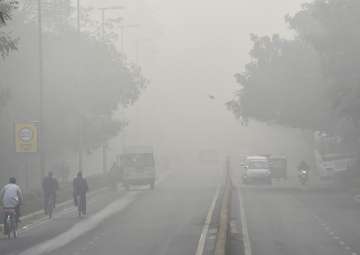The national capital on Tuesday saw improvement in the air quality with six out of 15 regions recording "very poor" levels rather than "severe" for the first time in the past week.
With wind speed almost doubling as compared to last week and chances of drizzle in NCR and neighbouring states, the air quality is set to improve further, falling under "very poor" or "poor" category, experts said.
According to the Central Pollution Control Board (CPCB) the average AQI of Delhi-NCR was 398 while the major pollutant PM2.5 or particles with diameter less than 2.5mm recorded 397 units at 6 p.m. -- considered "very poor".
However, the average AQI of Delhi at 6 p.m. was 407 with PM2.5 at 406 units, considered "severe".
This is considered an "improvement" as for past seven days since November 7, Delhi had been breathing toxic air with average AQI ranging between 460 to 500, on a scale of 0 to 500 and PM2.5 reached a dangerous 945 units at some places including Ghaziabad -- 37 times the safe limit.
"Delhi is out of emergency but not out of danger. In the coming days by November 16 and 17, the conditions are expected to get better. Unfortunately we are happy even though the air quality is very poor. In many countries there is an emergency-like condition at this air quality which we are cherishing as improvement," Usman Naseem, researcher at Centre for Science and Environment and member Supreme Court-appointed Environment Pollution Control Authority (EPCA), said.
According to data from System of Air Quality and Weather Forecasting And Research (SAFAR), six out of 10 monitoring stations across Delhi-NCR fell out of "severe" zone to "very poor". However, Lodhi Road in Central Delhi, Delhi University North Campus, Ayanagar in South Delhi and Pitampura in North Delhi continue to be 'severe'.
The most polluted region according to CPCB in Delhi-NCR includes Ghaziabad where at 6 p.m. the AQI was 471, Anand Vihar with AQI 458, Noida sector 125 with AQI 464 -- all considered 'severe'.
According to India Meteorological Department (IMD), the wind speed so far towards Delhi was 5 to 7 kmph coming from eastward, however the wind speed had suddenly increased to 10 to 15 kmph from north-west which would help in dispersing the pollutants hanging in the air.
"There are fair chances of drizzling tonight or early morning on Wednesday, November 15 in parts of Haryana and Punjab. Since the winds are coming from there with good speed, the pollutant there would first settle due to rains, so the winds entering Delhi would be pure and then speed would disperse the smog here," Charan Singh, chief weather forecast officer at IMD, said.
According to IMD, the improvement in air quality is also evident as the visibility has increased from 200 meters last week, than over 1,000 meters on Tuesday.
"The major reason for emergency situation in Delhi was stubble burning. The winds coming from Punjab were carrying pollutants and then there was moisture coming from the east. Both winds collided at low height in Delhi causing smog. We do not see improvement," Usman Naseem added.
Latest India News
